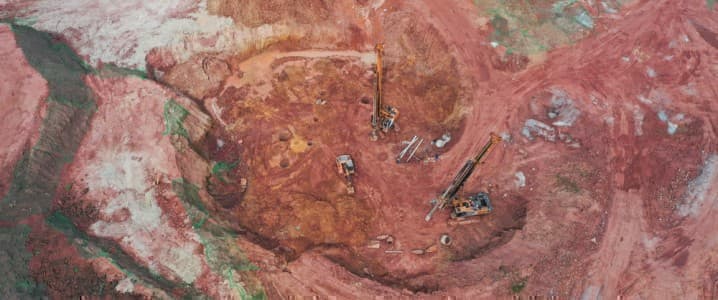Shares of Australian rare earths developers Lynas Rare Earths Ltd (OTCPK:LYSCF)(ASX:LYC) and Arafura Rare Earths Ltd (OTCPK:ARAFF)(ASX: ARU) have tanked after Tesla Inc. (NASDAQ:TSLA) outlined plans to stop using rare earths in its next-generation EVs at the company’s investor day event last week.
They aren’t alone. Rare Earths miners across the board are getting the wind knocked out of their sails, from East to West, from China to Australia.
Tesla has already cut rare earth usage in its cars by 25% in a bid to distance itself from the problematic supply chain, and last week’s announcement has upended this market segment.
LYSCF shares have lost ~10% over the past five trading sessions, accentuating a sharp slide that kicked off in February. The shares have now crashed 24% over the past 30 days while ARAFF is down 16% over the timeframe, virtually erasing early-year gains for LYSCF.
Just like what we have witnessed with the lithium markets over the past two years, EV makers have been scrambling to secure supplies of rare earths such as neodymium and praseodymium leading to a supply squeeze and skyrocketing prices.
EV makers use rare earths such as neodymium and praseodymium, or NdPr, in their permanent magnets. Neodymium prices jumped to 1.5 m
illion yuan per tonne in early 2022 from 203,000 yuan per tonne in the space of just six months amid an acute supply squeeze. Neodymium prices have since then undergone a big correction to trade at a current 815,000 yuan, still multiples higher to levels just a couple of years ago.
Adamas Intelligence and IDTechEx have said that Tesla will most likely shift to ferrite magnets, though they come with a significant weight and efficiency penalty.
The rare earth miner big selloff appears like overreaction considering that Adamas says it will affect less than 5% of the global NdFeB market:
"The global NdFeB market stands to lose a mere 2% to 3% of demand in the near-term, and maximum 3% to 4% over the long-term assuming Tesla maintains its EV market leadership," Adamas estimates.
LFP Batteries
This is hardly the first time that Tesla will be tinkering with its battery architecture.
Back in 2020, Tesla revealed that it’sswitching battery chemistry for all standard-range Models 3 and Y from nickel cobalt aluminum (NCA) chemistry to an alternative, older technology that uses a lithium iron phosphate (LFP) chemistry.
LFP cells not only have much longer useful lifetimes but are also cheaper than NCA or nickel manganese cobalt (NMC) cells. The biggest trade-off is that LFP batteries have a lower energy density. However, LFP batteries are still able to compensate for this shortcoming by dramatically cutting on thermal runaway in the event of a crash, meaning an LFP battery pack requires much less volume on cooling and structural protection to keep the cells separated.
Many electric buses in China already use LFP batteries. In 2020, Tesla introduced LFP batteries in its standard range Model 3s in China and dropped the starting price from 309,900 yuan ($48,080) to 249,900 yuan ($38,773). CEO Elon Musk has revealed that the improving energy density of LFP batteries now makes it possible to use the cheaper, cobalt-free batteries in its lower-end vehicles so as to free up more battery supply of lithium ion chemistry cells for Tesla’s other models.
Up to now, intellectual property restrictions have kept LFP cells mostly within China. But Tesla is now able to deploy them in its pivotal U.S. market after it won approval from the Chinese government to start using LFP batteries in Chinese-made BEVs in 2020. Indeed, Tesla is making the switch to LFP mandatory in all its markets after a positive reception in the U.S.
In December 2020,Bloomberg NEF, a clean energy research that has been, among other things, tracking battery costs, announced that battery costs had dipped below the $100 per kWh threshold for the first time ever. The crucial milestone was achieved for battery packs designed for electric buses in China. In the EV industry, the $100 per kWh battery cost price point is generally regarded as the Holy Grail critical for the wider adoption of electric vehicles by making them cost-competitive at the sticker price, which remains an important psychological barrier for many potential buyers. The powertrain typically accounts for more than 70% of the cost of an EV.
Unfortunately, the mad lithium rally reversed this trend: last year, E Source estimated thatbattery cell prices will surge 22% from 2023 through 2026, peaking at $138 per kilowatt-hour thus reversing a multi-year trend whereby battery pack and EV costs have fallen consistently each year.
Thankfully, the lithium rally has lately come unstuck: after hitting an all-time high of CNY 595,000 per tonne ($86,170 per tonne) in November 2022, lithium carbonate prices in China have sunk to a 13-month low ofCNY 362,500 per tonne ($52,500 per tonne) in March 2023, good for a nearly 40% correction as a confluence of negative catalysts conspired to end lithium’s biggest rally ever. Hopefully, battery costs will continue falling and help power the EV revolution.
By Alex Kimani for Oilprice.com
More Top Reads From Oilprice.com:
- EPA Takes Bold Steps To Curb Toxic Wastewater From Coal-Fired Plants
- OPEC Officials And U.S. Shale Executives Discuss Global Oil Supply
- Falling U.S. Container Imports Highlight Economic Weakness


















